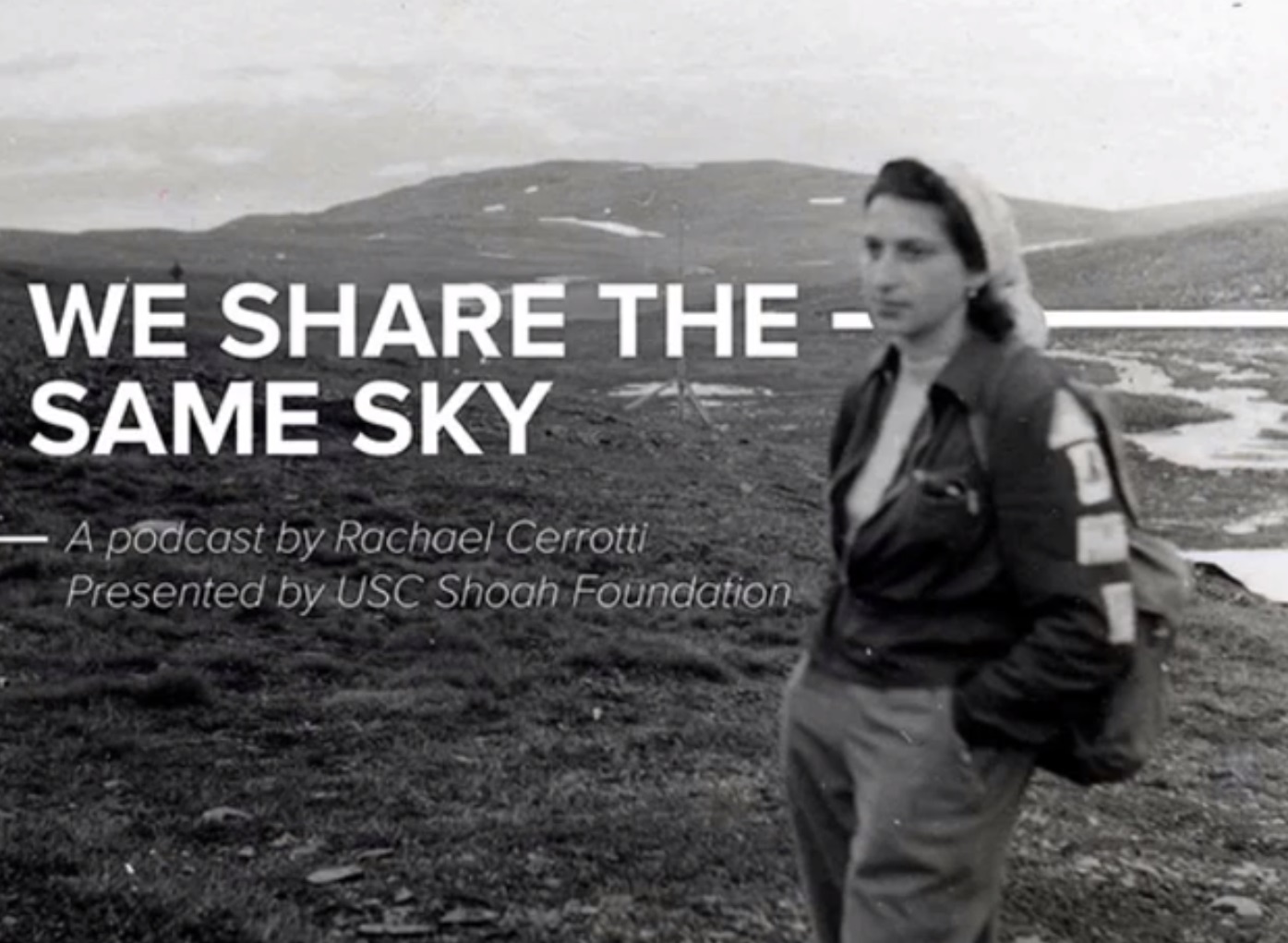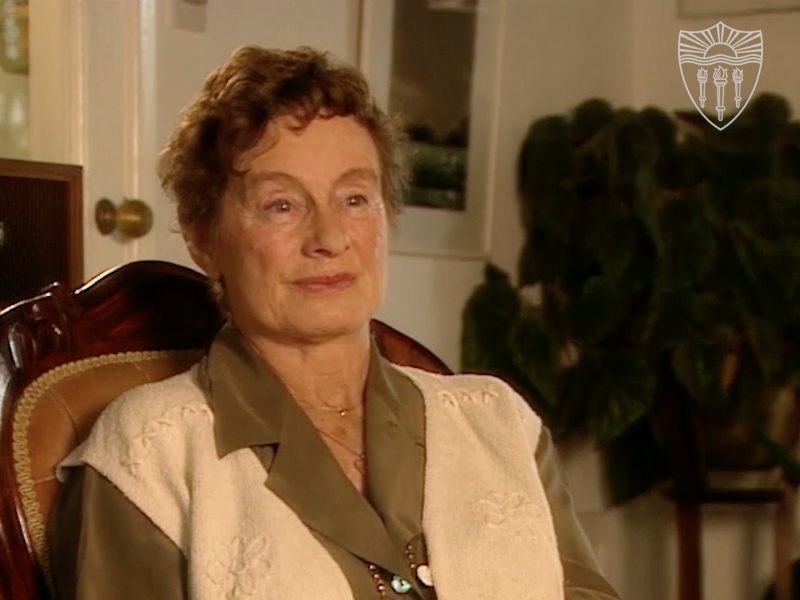TEACH
![]()
LESSON PLAN
EDUCATOR RESOURCE: LESSON PLANS
Our Lesson Plans provide a unique experience for educators to teach about the Holocaust effectively and interactively. The modular design of the lessons found within each unit allow for adaption and customization to specific grade levels and subject areas. The integration of rich content helps students construct an authentic and comprehensive portrait of the past as they frame their own thoughts about what they are learning, resulting in a deeper level of interest and inquiry. Each lesson includes:
- Step-by-step procedures
- Estimated completion time
- Resources labeled by icons






 direct teachers to the piece of content named in the procedures
direct teachers to the piece of content named in the procedures
- Print-ready pages as indicated by
 are available as PDFs for download
are available as PDFs for download
If you are new to teaching about the Holocaust, we encourage you to participate in one of our
online course offerings to support instruction ahead. As well, for teachers with limited instructional time seeking a starting point, we offer a sample
One Day Lesson Plan, as well as a sample
Day Two Lesson Plan for a 2nd class period of instruction.
For more information, questions or concerns please
contact us.
PEDAGOGY PRINCIPLES FOR EFFECTIVE HOLOCAUST INSTRUCTION
PEDAGOGICAL PRINCIPLES FOR EFFECTIVE HOLOCAUST INSTRUCTION
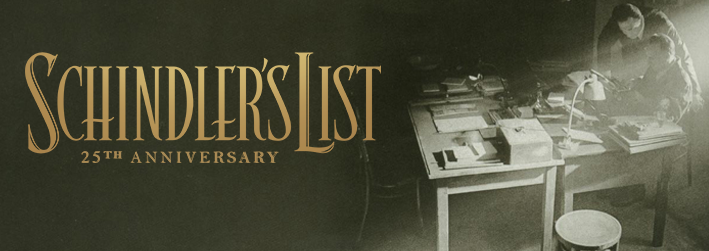
December 2018 marks the 25th anniversary of the release of Steven Spielberg’s Schindler’s List, which depicts the true story of Oskar Schindler—a man who saved the lives of more than 1,200 Jews during the Holocaust. It was Spielberg’s experience making this film that inspired him to collect and preserve the testimonies of over 54,000 Holocaust survivors and witnesses, a pursuit which ultimately led to the creation of what is now USC Shoah Foundation.
In honor of Universal Pictures’ rerelease of Schindler’s List, Echoes & Reflections has created a short, classroom-ready Companion Resource, that will help educators to provide important historical background and context to the film, as well as explore powerful true stories of rescue, survival, and resilience with their students.
Additionally, the following videos, recorded at Yad Vashem, feature Schindler survivors who speak of the impact Oskar Schindler had on their lives.
EVA LAVI TESTIMONY
Eva Lavi was the youngest survivor from Schindler’s list. She was two years old when the war began.
NAHUM & GENIA MANOR
Nahum Manor met and fell in love with his wife, Genia, in Schindler’s factory. Watch him read a letter at
Schindler’s gravesite, expressing what he meant to them.
CLASSROOM POSTER SERIES
INSPIRING THE HUMAN STORY
Echoes & Reflections is excited to announce that our poster series:
Inspiring the Human Story, is now available in PDF format,
free of cost.
The posters feature the powerful words and experiences of Holocaust survivor and memoirist
Elie Wiesel, Holocaust survivor
Kurt Messerschmidt, and Anne Frank rescuer,
Miep Gies. Each poster promotes meaningful conversation and reflection in the classroom, whether in person or in a virtual setting, and inspires students with powerful human stories of the Holocaust that can continue to guide agency and action as a result of studying this topic.
To support you in these efforts, we have also compiled several suggested
classroom activities from teachers in our network that may be of use and interest.
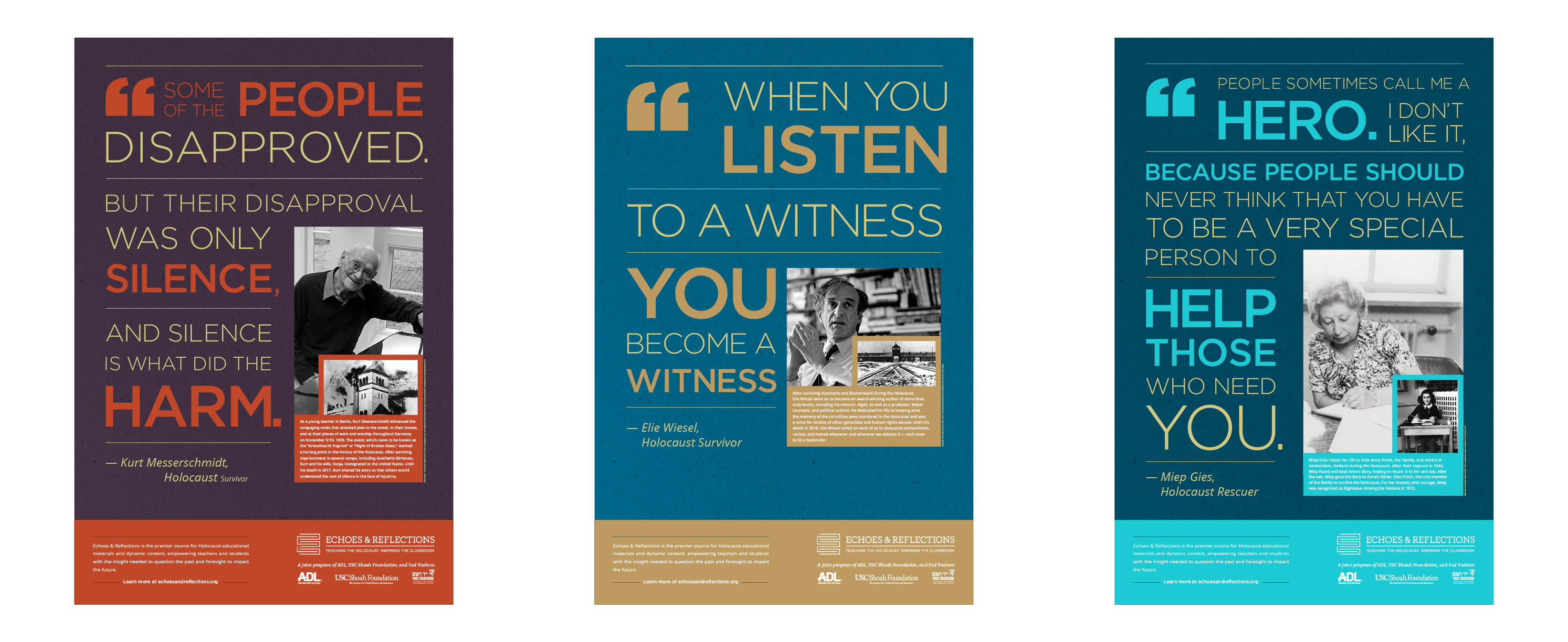
Please fill out the form below to access and download your PDF posters.
WE SHARE THE SAME SKY
USC Shoah Foundation’s first podcast, We Share The Same Sky, seeks to brings the past into present through a granddaughter’s decade-long journey to retrace her grandmother’s story of survival. We Share The Same Sky tells the two stories of these women—the grandmother, Hana, a refugee who remained one step ahead of the Nazis at every turn, and the granddaughter, Rachael, on a search to retrace her grandmother’s history.
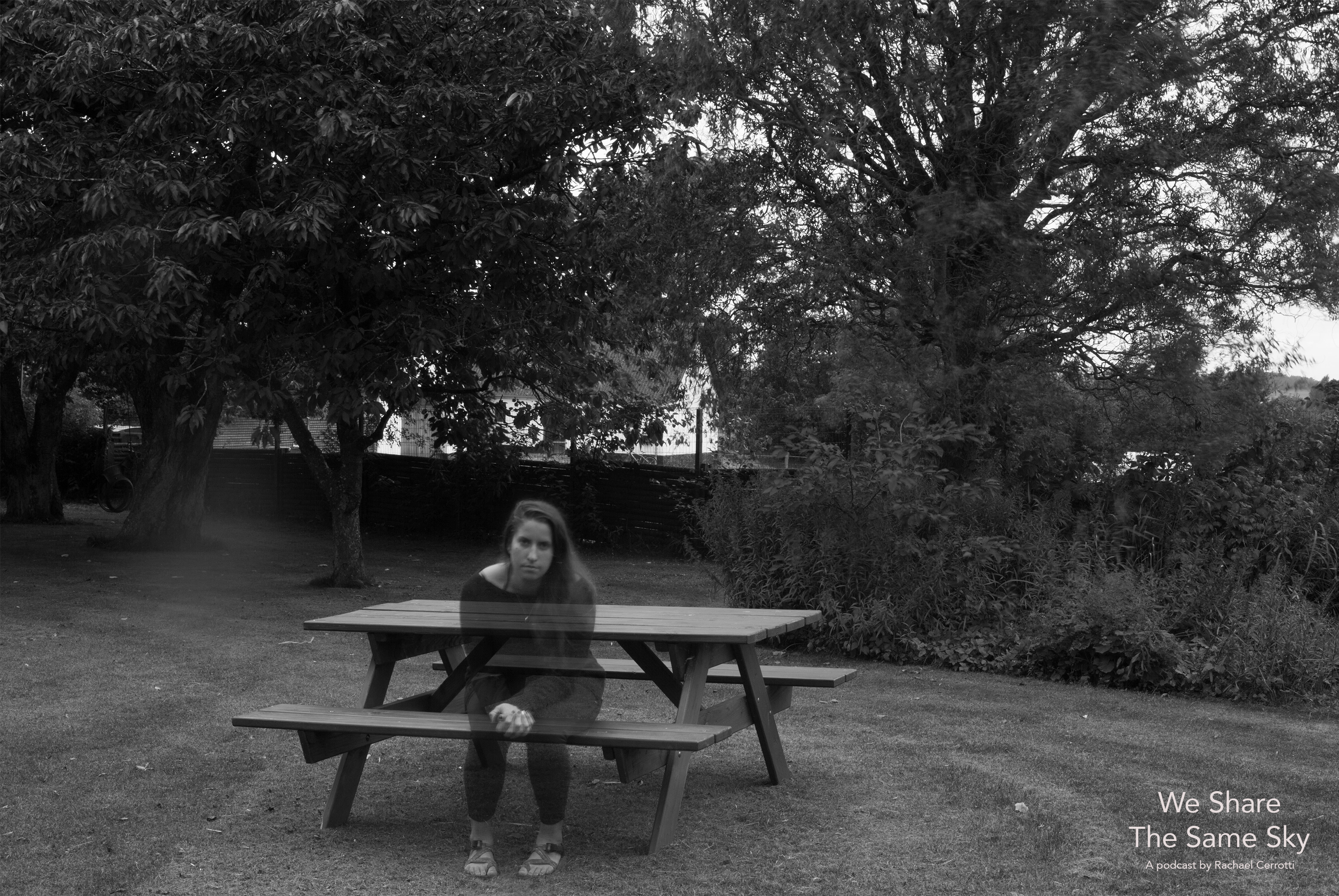 A self-portrait of Rachael while she is living on a Danish farm that is owned by the granddaughter of Hana’s foster mother from World War II. Photo by Rachael Cerrotti, 2017
A self-portrait of Rachael while she is living on a Danish farm that is owned by the granddaughter of Hana’s foster mother from World War II. Photo by Rachael Cerrotti, 2017
In order to enhance its classroom use, USC Shoah Foundation and Echoes & Reflections have created a Companion Educational Resource to support teachers as they introduce the podcast to their students. This document provides essential questions for students, as well as additional resources and content to help build context and framing for students’ understanding of the historical events addressed in the podcast.
Access to the podcast, as well as additional supporting materials—including IWitness student activities, academic standards alignment, and general strategies for teaching with podcasts—can all be found at the We Share The Same Sky page in IWitness.
Note: Due to the subject nature, the podcast is appropriate for older students, grades 10-12. As always, teachers should review the content fully in advance to determine its appropriateness for their student population.

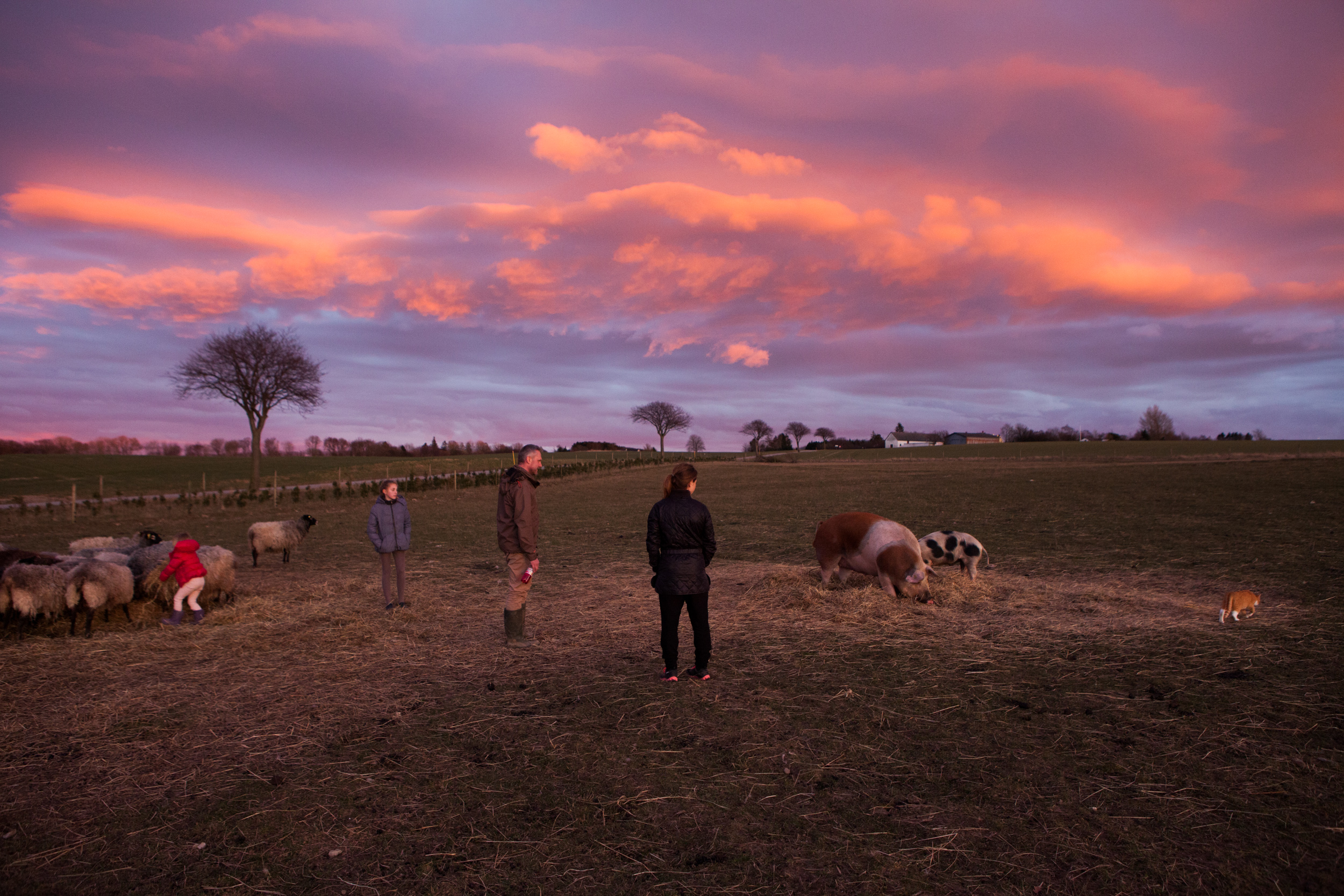 After many years of research and digitizing the archive her grandmother left behind, Rachael set out to retrace her grandmother’s 17 years of statelessness. Her intention was to travel via the same modes of transportation and to live similar style lives as to what her grandmother did during the war and in the years after. That meant that when she got to Denmark, she moved to a farm. Rachael moved in with the granddaughter of her grandmother’s foster mother from World War II and traded her labor for room and board as Hana once did. This picture is from that first visit in the winter of 2015. Since this time, Rachael has spent many more months living on this farm. It is owned by Sine Christiansen and her family. Sine is the granddaughter of Jensine, one Hana’s foster mother from World War II. Photo by Rachael Cerrotti, 2015
After many years of research and digitizing the archive her grandmother left behind, Rachael set out to retrace her grandmother’s 17 years of statelessness. Her intention was to travel via the same modes of transportation and to live similar style lives as to what her grandmother did during the war and in the years after. That meant that when she got to Denmark, she moved to a farm. Rachael moved in with the granddaughter of her grandmother’s foster mother from World War II and traded her labor for room and board as Hana once did. This picture is from that first visit in the winter of 2015. Since this time, Rachael has spent many more months living on this farm. It is owned by Sine Christiansen and her family. Sine is the granddaughter of Jensine, one Hana’s foster mother from World War II. Photo by Rachael Cerrotti, 2015
 A self portrait of Rachael overlooking the exact spot in Southern Sweden where her grandmother’s refugee boat came to shore in 1943. Photo by Rachael Cerrotti, 2016
A self portrait of Rachael overlooking the exact spot in Southern Sweden where her grandmother’s refugee boat came to shore in 1943. Photo by Rachael Cerrotti, 2016


![]() ESTIMATED COMPLETION TIME
ESTIMATED COMPLETION TIME60 minutes + time for research project
LESSON 3: Righteous Among the Nations
Introduction 
In this lesson, students learn about the designation, “Righteous Among the Nations,” and its significance in the history of the Holocaust. Using visual history testimony, primary source documents, and other texts, students investigate the actions and impact of rescuers designated as “Righteous,” and inquire into the importance of their stories in today’s world.
Post the supporting question above for students as you begin this part of the lesson.
| 1 | Students write the term selfless in the middle of a sheet of paper. They engage in a brief free-write in response to the following questions: “What does it mean to do something truly selfless? Is it important to be recognized for selfless acts?” Students write narratively, free associate, and/or sketch their thoughts and then share with a partner. The class learns that they will be investigating Holocaust rescuers who have been recognized for their selfless acts with the designation, “Righteous Among the Nations.”
|
| 2 | Students watch a testimony clip of a rescuer designated as “Righteous Among the Nations”: [L]Irene Gut-Opdyke[/L]. As they watch the clip, students take notes on the Testimony Reflections handout.
|
 IRENE GUT-OPDYKE
IRENE GUT-OPDYKE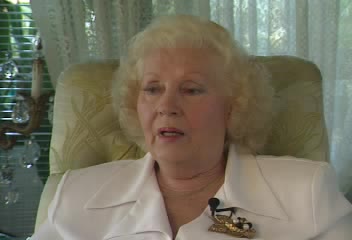
| 3 | After viewing the testimony clip, students journal or participate in a whole group discussion in response to some of the following questions:
|
What did Irene see that made her tremble and understand what was “really happening” for the first time? What impact did this have on her, and how can you tell?
What were the challenges and risks Irene faced as she helped the Jewish people hide and escape?
Why was Irene warned not to appear as a “Jew-lover”? Why do you think she chose to help despite this caution?
|
What does the comment “there was no time to think, just to do” reveal about rescuers?
How did Irene react when the group offered to give themselves up? What do you think caused her to say this?
How did you feel when Irene said she was “so happy I have a place for my friends”? What emotions come through from Irene and how did her story affect you?
|
| 4 | Students learn that Irene was designated as a “Righteous Among the Nations” and are provided with the following background information: 
|
 NOTEView More »
NOTEView More »
In 1953, the Knesset (Israeli parliament) passed the Holocaust Martyrs’ and Heroes’ Remembrance Authority Law, which created Yad Vashem. The law mandated that Yad Vashem identify and recognize non-Jews who had risked their lives during the Holocaust to save Jews in countries that had been under Nazi rule or that had collaborated with the German regime. In order to recognize people as Righteous, Yad Vashem set up a public Commission, headed by a Supreme Court Justice, which examines each case and is responsible for granting the title. Those recognized receive a medal and a certificate of honor and their names are commemorated on the Mount of Remembrance in Jerusalem. The medal is inscribed with a phrase from the Talmud, a Jewish religious text, that says, “He who saves one life saves the world entire.” The historical account of the Holocaust would not be complete without the extraordinary stories of the “Righteous Among the Nations.”
| 5 | In pairs, students discuss what they think the criteria should be for receiving the “Righteous” designation based on what they have learned about rescuers thus far. The handout, Yad Vashem Criteria for “Righteous Among the Nations” is then distributed and the class reviews together. Students discuss the following questions:
|
 STUDENT HANDOUTYad Vashem Criteria for “Righteous Among the Nations” View More »
STUDENT HANDOUTYad Vashem Criteria for “Righteous Among the Nations” View More »
Do you agree with the “Righteous Among the Nations” criteria? Is there anything you would add? Explain.
Did you think the number of individuals identified as “Righteous Among the Nations” would be higher? Why?
What surprises you about the information on the chart listing the “Righteous” by country? Does this data change your impression of certain nations or raise any questions for you?
|
What does it mean to an individual to be acknowledged for selfless and life-saving acts? What does it mean for the community around that person? How does this relate to a community that you belong to or know about?
What does the establishment of a project like this say about how victims of the Holocaust attempted to pay tribute to people who stood by their side at a time of persecution and tragedy?
|
Post the supporting question above for students as you begin this part of the lesson.
| 6 | Students learn that they will investigate a “Righteous Among the Nations” designee in detail, and create a “one-pager” reflecting their actions and impact. The “one-pager” is a physical or digital page on which students convey their unique understandings and insights in a creative fashion that incorporates textual and visual elements. The “one-pager” for this assignment:

|
 IWITNESS ACTIVITYRighteous Among the Nationshere »
IWITNESS ACTIVITYRighteous Among the Nationshere »
| 7 | Students work on their investigations individually, in pairs, or small groups. They are assigned one of the options below – a class investigation of the same individual using the handouts provided or an independent investigation of different individuals using online resources.
|
 STUDENT HANDOUTBudapest: Historical Background View More »
STUDENT HANDOUTBudapest: Historical Background View More »
 STUDENT HANDOUTA Swedish Rescuer in Budapest View More »
STUDENT HANDOUTA Swedish Rescuer in Budapest View More »
- Class investigation of Raoul Wallenberg, a Swedish diplomat who saved thousands of Jews in German-occupied Hungary by issuing protective passports and sheltering them in buildings designated as Swedish territory:
-
Read the handout, Budapest: Historical Background
-
Read the handout, A Swedish Rescuer in Budapest and note the actions and impact of the subject as well as your reactions
-
View the testimonies of Vera Goodkin, who was saved by Wallenberg, and Per Anger, a Swedish diplomat who served with Wallenberg (To view the testimonies, please click the link and navigate to the “Videos” tab). Use the Testimony Reflections handout to record reactions and ideas.
- Independent investigation of a subject from the “Righteous Among the Nations” Featured Stories page:
-
Choose a subject that includes a collection of photos, videos, and documents.
-
Read the story on the main page and note the actions and impact of the subject as well as your reactions.
-
Observe at least one photo and note what it reveals about the subject’s life or impact.
-
View at least one video and note what it reveals about the subject’s life or impact.
-
Analyze at least one document and note what it reveals about the actions and impact of the subject.
| 8 | Students’ “one-pagers” are displayed in a gallery online or in the classroom. Half of the class stands (physically or virtually) by their work and provides a brief tour or explanation of their “one-pagers’ to the other half of the class, who circulates and observes. Students then switch roles so that the tour guides become the observers. Students observe at least three of their classmates’ “one-pagers” in this way.
|
| 9 | Following the gallery walk, the class debriefs using the following questions:
|
Is the designation of “righteous” a useful one to bestow on certain people? Why?
Are rescuers heroes or ordinary people who performed heroic acts? Is there a difference? Explain.
How did rescuers make an impact beyond the individuals they helped directly?
|
|
| 10 | As a summative task, students respond to the Talmudic idea, “Whoever saves one life saves the world entire.” Using evidence from unit sources, they list at least five ways in which the behaviors of rescuers had an impact beyond the individuals whose lives they saved.
|
Making Connections

The ideas below are offered as ways to extend the lessons in this unit and make connections to related historical events, current issues, and students’ own experiences. These topics can be integrated directly into Echoes & Reflections lessons, used as stand-alone teaching ideas, or investigated by students engaged in project-based learning.
View More +
| 1 | Visit IWitness (iwitness.usc.edu) for testimonies, resources, and activities to help students learn more about rescuers and aid providers during the Holocaust.
|
| 2 | Write a letter to someone that you learned about in this unit. Tell the person what you are thinking and feeling after learning about their experiences.
|
| 3 | Think about the people you met in this unit. All of them see themselves as “ordinary” people and yet they all did extraordinary things. Write an essay in which you address the following questions: How might this be explained? Why do you think some people became rescuers during the Holocaust while most remained bystanders? What moral choices were made by rescuers during the Holocaust and what were the ongoing challenges they faced?
|
| 4 | Read either Anne Frank: The Diary of a Young Girl (Anchor Books, 1996) or Miep Gies’ Anne Frank Remembered: The Story of the Woman Who Helped to Hide the Frank Family (Touchstone, 1988). In small groups made up of students who have read both books, develop a graphic organizer comparing and contrasting the experiences of Anne Frank and Miep Gies. Refer to the Echoes & Reflections Timeline of the Holocaust to better understand the events in the books within the larger context of the Holocaust.
|
| 5 | View Yad Vashem’s online exhibit, Besa: A Code of Honor. It tells the story of the heroic actions of the people of Albania – the only European country with a Muslim majority – who rescued Jews during the Holocaust in keeping with their national code of honor, Besa (literally “to keep the promise”). Read the stories of at least three Albanians designated as “Righteous Among the Nations.” Create a portrait of one by sketching an outline of the individual(s) or a site in the story and filling the inside with writing and imagery that conveys how Besa was fulfilled. As a follow-up, write about your personal code of honor and how you can use these moral guidelines to help others.
|
| 6 | Together with a partner, choose one of the following poems, written by survivors who were part of the Kindertransport and examining questions of guilt and duty: Holocaust 1944 and When It Happened. Read the poem together and discuss or write in response to some of the following questions:
- Who is the speaker in the poem? To whom is she speaking? What is their relationship to one another?
- What emotions is the speaker experiencing? What do you think might be causing these emotions?
- What is the theme of the poem? Pick out one line or stanza that you believe contributed significantly to the theme of the poem and explain why you selected this particular line or stanza.
- What questions are left unanswered for you, as the reader? Why are these questions unanswered?
|
| 7 | Write about a time when you made a conscious decision to help someone in a difficult situation or about a time when someone came forward to help you. Describe the event in detail and tell how you felt during the situation. What were some of the complications or difficulties that you faced? Were there any moral or ethical dilemmas that needed to be addressed? What were your feelings after the situation ended?
|
Close -
 ESTIMATED COMPLETION TIME
ESTIMATED COMPLETION TIME120 Minutes
LESSON 2: Groups that Rescued
Introduction 
In this lesson, students consider groups of people that engaged in rescue efforts during the Holocaust. Through textual sources and excerpts from a podcast, students investigate the conditions in Denmark that allowed for the rescue of over 7,000 Jews in that nation. Students then analyze visual history testimonies and primary source documents to learn why the Kindertransport program in Great Britain was an exceptional example of rescue.
Post the supporting question above for students as you begin this part of the lesson.
| 1 | In pairs, students discuss the prompt below. The class then gathers and focuses on the examples of groups who helped others. They consider what conditions or influences might have enabled these groups to overcome the bystander effect.
|
In psychology, the “bystander effect” says the more people there are who witness someone in distress, the less responsible each individual feels to help. The likelihood that a person will receive help decreases as the number of witnesses increases. Discuss one instance in which a group of people neglected to help or acted to help someone in need. Why do you think the group behaved as it did in that instance?
| 2 | Students learn that, during this lesson, they will explore groups who helped Jewish victims of the Holocaust despite the many pressures to remain uninvolved. They begin by listening to excerpts from the podcast, We Share the Same Sky. Chapter V of the podcast recounts the rescue operation carried out by large numbers of Danish people that saved 7,200 Jewish lives in October 1943. 
|
| 3 | Students prepare a character map to be completed while listening to the podcast. Before listening, students are introduced to the story’s three central characters and note information about them in the center of their map. While listening, students add other characters from the story to their maps. For each character, they list their role, how they helped, and/or why they helped (The handout, We Share the Same Sky Excerpts, includes a transcript of the passages for students who would benefit from a text version).

|
 STUDENT HANDOUTWe Share the Same Sky Excerpts View More »
STUDENT HANDOUTWe Share the Same Sky Excerpts View More »
| 4 | Students further reflect on the rescue operation through an analysis of quotes by people who were part of Danish society at the time. Each student receives a quote, cut apart from the handout Quotes: Danish Rescue and Resistance. (As there are only 12 quotes, more than one student may receive the same quote.) Students move around the room and find a partner. The partners read aloud and discuss their quotes. They add new “characters” to their maps, noting the motivations of rescuers. Students find a new partner and repeat this process until they have considered at least three quotes. 
|
 STUDENT HANDOUTQuotes: Danish Rescue and Resistance View More »
STUDENT HANDOUTQuotes: Danish Rescue and Resistance View More »
 NOTEView More »
NOTEView More »
| 5 | Individually or in pairs, students read the Rescue in Denmark handout for additional context on the rescue operation. They annotate the handout by highlighting the roles and motivations of people who helped Jews, focusing particularly on “The Elsinore Sewing Club.” Students continue to add information to their character maps.
|
| 6 | Students share their character maps in small groups and identify common behaviors and motivations across the various members of Danish society. The class gathers and discusses some of the following questions:
|
How was the situation for Danish Jews different from that of Jews in other German-occupied countries? How did things change beginning in 1943?
How and why did members of “The Elsinore Sewing Club” get involved in rescue efforts? What consequences did they suffer for their actions?
|
In general, what commonalities did you observe regarding the motivations of Danish people who supported the rescue efforts? What were their stated reasons for helping?
Why do you think so many Christian Danes were willing to aid Jewish people when antisemitism throughout Europe was so widespread?
What types of cultural and political systems in a nation allow for moral action such as the rescue in Denmark?
|
Post the supporting question above for students as you begin this part of the lesson.
| 7 | The handout, Background: Kindertransport, is projected or distributed. Individually or as a class, students read this brief overview and note any questions that arise for them about the Kindertransport program. These questions are posted so that the class can revisit them as they learn more.
|
| 8 | Students watch testimony clips of Jewish survivors who were part of the Kindertransport: [L]Eric Richmond[/L], [L]Lynn Orne[/L], and [L]Vera Gissing[/L]. As they watch the clips, students take notes on the Testimony Reflections handout.
|
| 9 | After viewing the testimony clips, students journal or participate in a whole group discussion in response to some of the following questions:
|
 IWITNESS ACTIVITYThe Kindertransport: History and Individual Experienceshere »
IWITNESS ACTIVITYThe Kindertransport: History and Individual Experienceshere »
When Eric Richmond shares, “I didn’t want to go,” what feelings do you imagine this 15-year-old boy experienced on the day of his transport? What emotions might his parents have been going through as they convinced him to go?
When the grown-ups told the children that they would follow in several weeks, do you think they believed this themselves? Explain.
|
What awareness did these survivors have, as children, about why they were being sent away? What impact might this have had on such young people?
Why does Lynn Orne say that her “one overwhelming feeling was gratitude to my parents”?
What acts of kindness did Vera Gissing’s foster family exhibit? What did this mean to Vera?
|
| 10 | Students analyze primary documents that deepen their understanding of public sentiment regarding the Jewish refugee crisis in the late 1930s. In pairs, students are assigned one of the handouts below to examine. After reading the document, they discuss and/or write responses to the “Think it Through” questions on the handout. Then two pairs who have read different documents join together. Each pair presents a summary of their document and, as a group, they compare British and American viewpoints as represented in the source material. Through this exercise, the class considers how exceptional it was for Great Britain to accept Jewish refugees in a climate in which most other nations had closed their doors. 
- Lord Baldwin’s Appeal, Great Britain, 1938
- Letter to the Editor, Arizona Republic, 1939
|
 STUDENT HANDOUTLord Baldwin’s Appeal, Great Britain, 1938 View More »
STUDENT HANDOUTLord Baldwin’s Appeal, Great Britain, 1938 View More »
 STUDENT HANDOUTLetter to the Editor, Arizona Republic, 1939 View More »
STUDENT HANDOUTLetter to the Editor, Arizona Republic, 1939 View More »
 NOTEView More »
NOTEView More »
| 11 | Students review letters written by the parents of Kindertransport children in order to consider their experiences and what they sacrificed to rescue their own children. In small groups, students are assigned one or both of the documents below. After reading the background and letters, they select three of the “Reflect and Respond” questions to explore through writing or discussion.
- Postcards from a Father
- Letters from a Mother
|
| 12 | As a summative task, students respond to the words below from Rabbi Bent Melchior in We Share the Same Sky. Students fold a sheet of paper in half. On one side, they list at least three ways in which Holocaust rescuers embody the idea in the quote, citing evidence from lesson sources. On the other side of the sheet of paper, they list at least three ways in which they can apply this idea to their own lives.
“You cannot help the whole world. But those that are within your reach, you can treat and respect as human beings.”
|
 ESTIMATED COMPLETION TIME
ESTIMATED COMPLETION TIME60 minutes + time for research project
LESSON 3: Righteous Among the Nations
Introduction 
In this lesson, students learn about the designation, “Righteous Among the Nations,” and its significance in the history of the Holocaust. Using visual history testimony, primary source documents, and other texts, students investigate the actions and impact of rescuers designated as “Righteous,” and inquire into the importance of their stories in today’s world.
Post the supporting question above for students as you begin this part of the lesson.
| 1 | Students write the term selfless in the middle of a sheet of paper. They engage in a brief free-write in response to the following questions: “What does it mean to do something truly selfless? Is it important to be recognized for selfless acts?” Students write narratively, free associate, and/or sketch their thoughts and then share with a partner. The class learns that they will be investigating Holocaust rescuers who have been recognized for their selfless acts with the designation, “Righteous Among the Nations.”
|
| 2 | Students watch a testimony clip of a rescuer designated as “Righteous Among the Nations”: [L]Irene Gut-Opdyke[/L]. As they watch the clip, students take notes on the Testimony Reflections handout.
|
 IRENE GUT-OPDYKE
IRENE GUT-OPDYKE
| 3 | After viewing the testimony clip, students journal or participate in a whole group discussion in response to some of the following questions:
|
What did Irene see that made her tremble and understand what was “really happening” for the first time? What impact did this have on her, and how can you tell?
What were the challenges and risks Irene faced as she helped the Jewish people hide and escape?
Why was Irene warned not to appear as a “Jew-lover”? Why do you think she chose to help despite this caution?
|
What does the comment “there was no time to think, just to do” reveal about rescuers?
How did Irene react when the group offered to give themselves up? What do you think caused her to say this?
How did you feel when Irene said she was “so happy I have a place for my friends”? What emotions come through from Irene and how did her story affect you?
|
| 4 | Students learn that Irene was designated as a “Righteous Among the Nations” and are provided with the following background information: 
|
 NOTEView More »
NOTEView More »
In 1953, the Knesset (Israeli parliament) passed the Holocaust Martyrs’ and Heroes’ Remembrance Authority Law, which created Yad Vashem. The law mandated that Yad Vashem identify and recognize non-Jews who had risked their lives during the Holocaust to save Jews in countries that had been under Nazi rule or that had collaborated with the German regime. In order to recognize people as Righteous, Yad Vashem set up a public Commission, headed by a Supreme Court Justice, which examines each case and is responsible for granting the title. Those recognized receive a medal and a certificate of honor and their names are commemorated on the Mount of Remembrance in Jerusalem. The medal is inscribed with a phrase from the Talmud, a Jewish religious text, that says, “He who saves one life saves the world entire.” The historical account of the Holocaust would not be complete without the extraordinary stories of the “Righteous Among the Nations.”
| 5 | In pairs, students discuss what they think the criteria should be for receiving the “Righteous” designation based on what they have learned about rescuers thus far. The handout, Yad Vashem Criteria for “Righteous Among the Nations” is then distributed and the class reviews together. Students discuss the following questions:
|
 STUDENT HANDOUTYad Vashem Criteria for “Righteous Among the Nations” View More »
STUDENT HANDOUTYad Vashem Criteria for “Righteous Among the Nations” View More »
Do you agree with the “Righteous Among the Nations” criteria? Is there anything you would add? Explain.
Did you think the number of individuals identified as “Righteous Among the Nations” would be higher? Why?
What surprises you about the information on the chart listing the “Righteous” by country? Does this data change your impression of certain nations or raise any questions for you?
|
What does it mean to an individual to be acknowledged for selfless and life-saving acts? What does it mean for the community around that person? How does this relate to a community that you belong to or know about?
What does the establishment of a project like this say about how victims of the Holocaust attempted to pay tribute to people who stood by their side at a time of persecution and tragedy?
|
Post the supporting question above for students as you begin this part of the lesson.
| 6 | Students learn that they will investigate a “Righteous Among the Nations” designee in detail, and create a “one-pager” reflecting their actions and impact. The “one-pager” is a physical or digital page on which students convey their unique understandings and insights in a creative fashion that incorporates textual and visual elements. The “one-pager” for this assignment:

|
 IWITNESS ACTIVITYRighteous Among the Nationshere »
IWITNESS ACTIVITYRighteous Among the Nationshere »
| 7 | Students work on their investigations individually, in pairs, or small groups. They are assigned one of the options below – a class investigation of the same individual using the handouts provided or an independent investigation of different individuals using online resources.
|
 STUDENT HANDOUTBudapest: Historical Background View More »
STUDENT HANDOUTBudapest: Historical Background View More »
 STUDENT HANDOUTA Swedish Rescuer in Budapest View More »
STUDENT HANDOUTA Swedish Rescuer in Budapest View More »
- Class investigation of Raoul Wallenberg, a Swedish diplomat who saved thousands of Jews in German-occupied Hungary by issuing protective passports and sheltering them in buildings designated as Swedish territory:
-
Read the handout, Budapest: Historical Background
-
Read the handout, A Swedish Rescuer in Budapest and note the actions and impact of the subject as well as your reactions
-
View the testimonies of Vera Goodkin, who was saved by Wallenberg, and Per Anger, a Swedish diplomat who served with Wallenberg (To view the testimonies, please click the link and navigate to the “Videos” tab). Use the Testimony Reflections handout to record reactions and ideas.
- Independent investigation of a subject from the “Righteous Among the Nations” Featured Stories page:
-
Choose a subject that includes a collection of photos, videos, and documents.
-
Read the story on the main page and note the actions and impact of the subject as well as your reactions.
-
Observe at least one photo and note what it reveals about the subject’s life or impact.
-
View at least one video and note what it reveals about the subject’s life or impact.
-
Analyze at least one document and note what it reveals about the actions and impact of the subject.
| 8 | Students’ “one-pagers” are displayed in a gallery online or in the classroom. Half of the class stands (physically or virtually) by their work and provides a brief tour or explanation of their “one-pagers’ to the other half of the class, who circulates and observes. Students then switch roles so that the tour guides become the observers. Students observe at least three of their classmates’ “one-pagers” in this way.
|
| 9 | Following the gallery walk, the class debriefs using the following questions:
|
Is the designation of “righteous” a useful one to bestow on certain people? Why?
Are rescuers heroes or ordinary people who performed heroic acts? Is there a difference? Explain.
How did rescuers make an impact beyond the individuals they helped directly?
|
|
| 10 | As a summative task, students respond to the Talmudic idea, “Whoever saves one life saves the world entire.” Using evidence from unit sources, they list at least five ways in which the behaviors of rescuers had an impact beyond the individuals whose lives they saved.
|
Making Connections

The ideas below are offered as ways to extend the lessons in this unit and make connections to related historical events, current issues, and students’ own experiences. These topics can be integrated directly into Echoes & Reflections lessons, used as stand-alone teaching ideas, or investigated by students engaged in project-based learning.
View More +
| 1 | Visit IWitness (iwitness.usc.edu) for testimonies, resources, and activities to help students learn more about rescuers and aid providers during the Holocaust.
|
| 2 | Write a letter to someone that you learned about in this unit. Tell the person what you are thinking and feeling after learning about their experiences.
|
| 3 | Think about the people you met in this unit. All of them see themselves as “ordinary” people and yet they all did extraordinary things. Write an essay in which you address the following questions: How might this be explained? Why do you think some people became rescuers during the Holocaust while most remained bystanders? What moral choices were made by rescuers during the Holocaust and what were the ongoing challenges they faced?
|
| 4 | Read either Anne Frank: The Diary of a Young Girl (Anchor Books, 1996) or Miep Gies’ Anne Frank Remembered: The Story of the Woman Who Helped to Hide the Frank Family (Touchstone, 1988). In small groups made up of students who have read both books, develop a graphic organizer comparing and contrasting the experiences of Anne Frank and Miep Gies. Refer to the Echoes & Reflections Timeline of the Holocaust to better understand the events in the books within the larger context of the Holocaust.
|
| 5 | View Yad Vashem’s online exhibit, Besa: A Code of Honor. It tells the story of the heroic actions of the people of Albania – the only European country with a Muslim majority – who rescued Jews during the Holocaust in keeping with their national code of honor, Besa (literally “to keep the promise”). Read the stories of at least three Albanians designated as “Righteous Among the Nations.” Create a portrait of one by sketching an outline of the individual(s) or a site in the story and filling the inside with writing and imagery that conveys how Besa was fulfilled. As a follow-up, write about your personal code of honor and how you can use these moral guidelines to help others.
|
| 6 | Together with a partner, choose one of the following poems, written by survivors who were part of the Kindertransport and examining questions of guilt and duty: Holocaust 1944 and When It Happened. Read the poem together and discuss or write in response to some of the following questions:
- Who is the speaker in the poem? To whom is she speaking? What is their relationship to one another?
- What emotions is the speaker experiencing? What do you think might be causing these emotions?
- What is the theme of the poem? Pick out one line or stanza that you believe contributed significantly to the theme of the poem and explain why you selected this particular line or stanza.
- What questions are left unanswered for you, as the reader? Why are these questions unanswered?
|
| 7 | Write about a time when you made a conscious decision to help someone in a difficult situation or about a time when someone came forward to help you. Describe the event in detail and tell how you felt during the situation. What were some of the complications or difficulties that you faced? Were there any moral or ethical dilemmas that needed to be addressed? What were your feelings after the situation ended?
|






 direct teachers to the piece of content named in the procedures
direct teachers to the piece of content named in the procedures are available as PDFs for download
are available as PDFs for download










